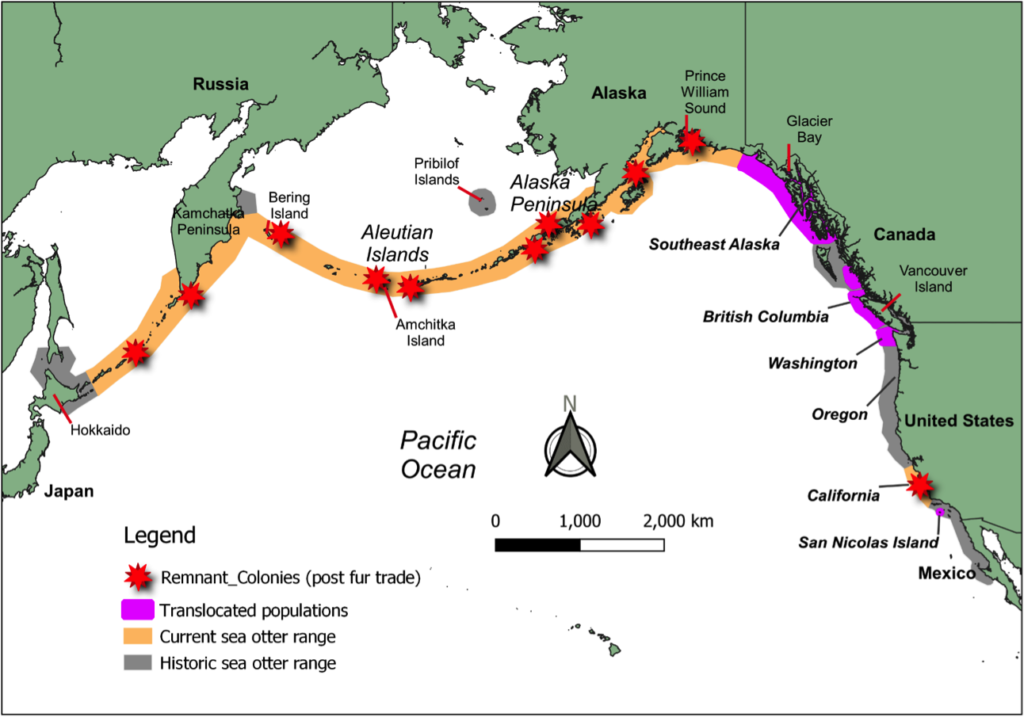
Chapter 2: History of Prior Sea Otter Translocation

Short Summary
This chapter provides an overview of previous sea otter translocation and reintroduction efforts over the past century. Over the past 80 years, nearly 1,000 sea otters have been captured, held, transported, and released into unoccupied habitats to restore populations. In the earliest translocations, inadequate attention was given to the physiological needs for the sea otters to maintain the integrity of their pelage, and high mortality resulted from poor animal husbandry practices during holding and transport. Comparing the methods, goals, and outcomes of these previous efforts yields inferences about factors and variables that might predict success or failure in any future reintroductions.
Reintroductions of wildlife are often employed to mitigate the direct or indirect effects of human activities that result in the loss or reduction of a species in all or parts of their historical habitat. Translocation success depends on a variety of recognized factors: the appropriate number and health of founding individuals, suitable habitat, adequate food resources, and realized reproductive potential and survival rates. The feasibility of reintroducing sea otters to the Oregon Coast must include a comprehensive review of prior sea otter translocations and an evaluation of specific translocation goals.
The first documented translocation of sea otters was conducted in Russia, in 1937, when nine sea otters were captured at Medny Island, in the Commander Islands, for transport to the Murman Coast in the southern Barents Sea (more than 5,000 km from their natural distribution in the north Pacific) to establish an additional colony to supplement Russian fur production. Initial efforts to restore sea otter populations within their historic range along the coasts of North America began in 1951. High mortality during holding and transport in the initial Russian and American attempts identified the critical need for sea otters to maintain the integrity of their fur to achieve thermal neutrality. Early husbandry practices failed to provide adequate quantities of food and provisioned otters with atypical foods. Access to clean water and appropriate food and space while in holding and transport proved to be instrumental in reducing mortality and improving future translocation successes.
The first successful North American translocation took place in 1965 when 41 sea otters were captured and moved by amphibious aircraft from Prince William Sound to Southeast Alaska. This project was the beginning of 13 separate translocations of 708 individuals from Amchitka Island and Prince William Sound to Southeast Alaska, British Columbia, and Washington between 1965 and 1972. These efforts established the feasibility of reintroductions as a tool to enhance the recovery of sea otters across their range.
Five translocations to the Pribilof Islands in the Bering Sea occurred between 1951 and 1968, and a translocation effort to Oregon was made in the early 1970s. Both of these translocations eventually failed to establish sea otter populations in those areas. In Oregon, surveys reported declining abundance from the initial 93 animals translocated in 1970 and 1971; by 1981, researchers could only find a single animal. These translocation failures highlighted two key points: 1) the success or failure of reintroductions can take a decade or more to become manifest; 2) frequent and systematic monitoring of post-release populations during that first decade could help inform management actions to influence successful establishment. Lack of prey abundance was probably not a factor in the failure of the Oregon effort or the delayed success of other translocations.
The most recent translocation occurred in California between 1987 and 1990, when the U.S. Fish and Wildlife Service moved 139 animals from the mainland central coast to San Nicolas Island, 110 km off the state’s southern coast. This was the first translocation explicitly intended to aid in the recovery of the ESA-listed southern subspecies of sea otter. It was also the first translocation to rigorously evaluate the health of individuals, define specific age and sex of animals to be moved, and closely monitor the translocated animals afterrelease. The San Nicolas translocation determined that abundant habitat and prey resources are not by themselves sufficient to ensure high retention rates of introduced animals. Behavioral factors, likely related to familiarity with established home ranges and social relations, contributed to the initial emigration of translocated animals. Unanticipated sources of mortality (such as fishing gear entanglement) can adversely affect growth rates when the population size is small. And limiting the distribution of sea otters to a defined translocation zone (a requirement of the translocation authorization to keep otters from migrating into commercial shellfish harvesting areas) proved impossible.
Between 2001 and 2017, a total of 37 stranded pups were raised at the Monterey Bay Aquarium with non-releasable adult female sea otters acting as surrogate mothers. This effort is notable for several reasons: 1) it engaged captive adult female surrogates in the rehabilitation and raising of stranded juvenile sea otters explicitly for release over time; 2) animals were held and raised in captivity for extended periods during their development, a step that may have facilitated socialization and development of bonds among the animals that would eventually be released; 3) the animals were released into a sheltered, soft sediment estuarine environment rather than coastal rocky reef habitats; 4) this reintroduction process did not incur the large-scale losses of individuals through emigration or mortality that were ubiquitous in earlier translocations.
In all translocations for which there are data, the numbers of sea otters reintroduced declined rapidly following release; in most cases, numbers appeared to stabilize at 10-50% of the original number released. Because of limited monitoring efforts and follow-up surveys after most of the translocations, the causes behind this rapid diminishment following introductions are not well understood. But the finding demonstrates that otters have a strong individual affinity for their established home range and will disperse despite translocation to suitable habitat with abundant prey. Once fully established, translocated populations generally demonstrated growth at or near the maximum feasible rate for sea otters (averaging about 20% per annum), much higher than growth rates observed in remnant populations.
The chapter offers four conclusions:
- The lack of understanding about the basic physiology of sea otters—their dependence on maintaining a thermal balance through their pelage and their unusually high metabolic requirements—explains the failure of early translocations.
- Given suitable habitat, prey resources, and protection from human or other mortality sources, sea otters can survive and thrive following translocations.
- Successful reintroductions undergo an establishment phase during which a variety of factors (e.g., emigration, mortality) tend to reduce the founding population to a small fraction of the number of animals released.
- The role that sea otter translocations can play in restoring coastal marine ecosystem structure and function, and in recovering genetic diversity and connectivity among sea otter populations, provides ample justification for considering new reintroductions to restore sea otter populations and coastal ecosystems.
See Figure 2.1 and Table 2.1 below for a map and statistics from prior translocations.

Figure 2.1. Map of the North Pacific showing historical and current sea otter range, the latter including translocated populations. Location of the remnant colonies left at the end of the fur trade (from which present-day populations are descended) are also shown.
Table 2.1 Summary statistics for ten previous sea otter translocation and reintroduction efforts.


